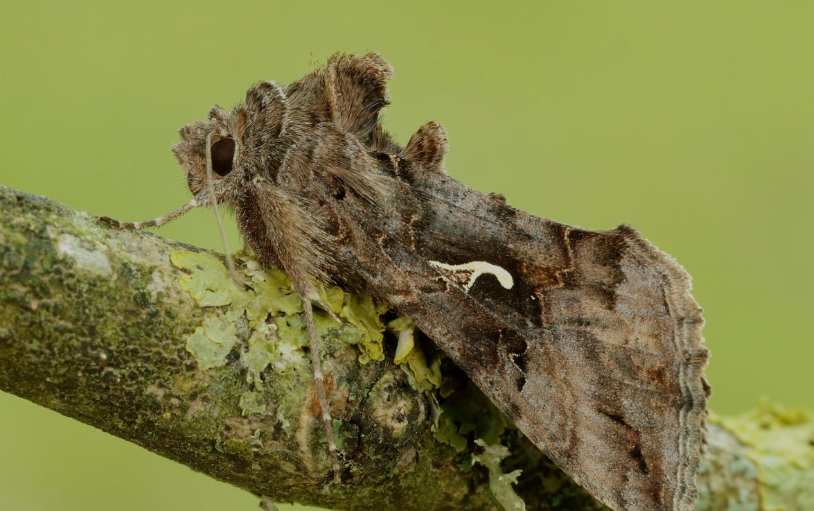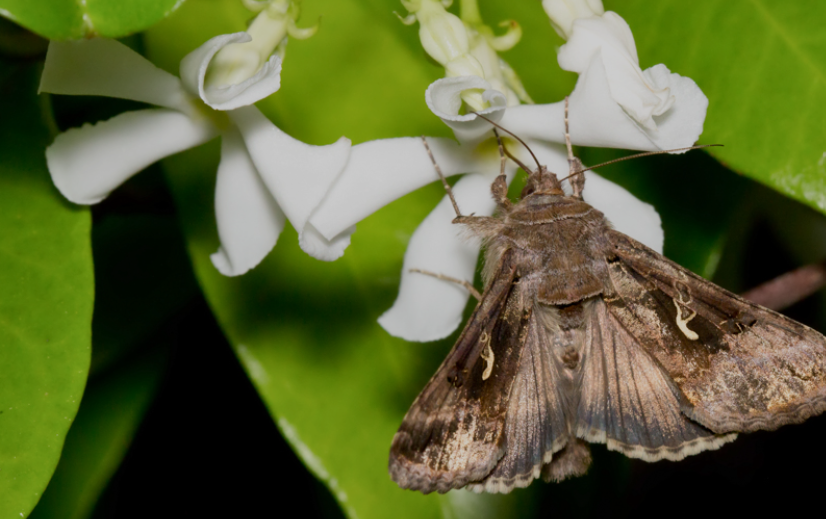
Classification
The Silver Y Moth (Autographa gamma) belongs to the family Noctuidae, commonly referred to as owlet moths. It is part of the genus Autographa, which includes many species of small to medium-sized moths. This species is classified within the order Lepidoptera, sharing this group with butterflies and other moths. Its classification reflects its nocturnal habits, migratory behavior, and unique wing markings that distinguish it from other moth species.
Identifying Characteristics
The Silver Y Moth is named for the distinctive silver Y-shaped mark on each of its forewings. Adult moths typically have a wingspan of 1.4–1.8 inches (35–45 mm), with brownish or grey forewings and lighter hindwings. The combination of their metallic marking and quick, fluttering flight makes them easily recognizable. They are generally active at night but can also be seen during the day, especially while feeding on flowers.
Distribution
Autographa gamma is widespread across Europe, parts of Asia, and North Africa. It is one of the few moth species known for regular long-distance migrations, allowing it to colonize new areas seasonally. Their distribution can vary year by year depending on weather conditions and availability of suitable host plants.
Migration & Habitat
The Silver Y Moth is a migratory species, traveling hundreds of miles during spring and autumn to reach areas with abundant flowering plants and suitable breeding grounds. It inhabits gardens, meadows, farmland, and open fields, showing a preference for areas rich in nectar sources. These moths are adaptable to both rural and urban environments, often visiting backyard flowers and crops.
Predators & Threats
Natural predators of the Silver Y Moth include birds, bats, spiders, and predatory insects. Their populations can also be affected by pesticide use, habitat loss, and artificial lighting, which can disrupt nocturnal activity. Despite these threats, the species remains abundant due to its migratory nature and broad range of habitats.
Lifespan of Adults
Adult Silver Y Moths typically live for 2–3 weeks, during which their primary activities include feeding and reproduction. Their migratory lifestyle allows them to exploit seasonal blooms across different regions, maximizing reproductive opportunities during their short lifespan.
Host Plants & Diet
The larvae of the Silver Y Moth feed on a wide variety of herbaceous plants, including crops such as cabbage, peas, lettuce, clover, and tobacco, making them occasional agricultural pests. Adult moths feed on nectar from flowers, including thistles, marigolds, and buddleia. By consuming nectar, they play a role in pollination, while the larvae contribute to ecosystem herbivory.
Lifecycle of Silver Y Moth (Autographa gamma)

Egg Stage
The life cycle begins when the female lays small, pale green or yellow eggs on the leaves of host plants such as cabbage, peas, lettuce, and clover. Eggs are usually laid individually or in small clusters and hatch within 4–8 days, depending on temperature and environmental conditions.
Larval (Caterpillar) Stage
After hatching, the larvae emerge as green caterpillars with faint stripes, which helps them camouflage on leaves. They feed voraciously on host plant foliage and grow rapidly, undergoing five to six instars (molts). During this stage, they are vulnerable to predators such as birds, spiders, and parasitic insects.
Pupal Stage
Once fully grown, the caterpillar forms a pupa in the soil or among leaf litter near the host plant. Inside the pupal case, the caterpillar undergoes complete metamorphosis, transforming into an adult moth. The pupal stage lasts about 10–20 days, though it may be prolonged if environmental conditions are unfavorable, with pupae sometimes entering diapause during cold periods.
Adult Stage
The adult Silver Y Moth emerges with fully formed wings, ready to feed and reproduce. Adults are active both during the day and night, feeding on nectar from flowers using their long proboscis. Their lifespan is 2–3 weeks, focused primarily on mating, laying eggs, and migrating to new areas. They are notable for their long-distance migratory behavior, which helps them colonize new regions seasonally.